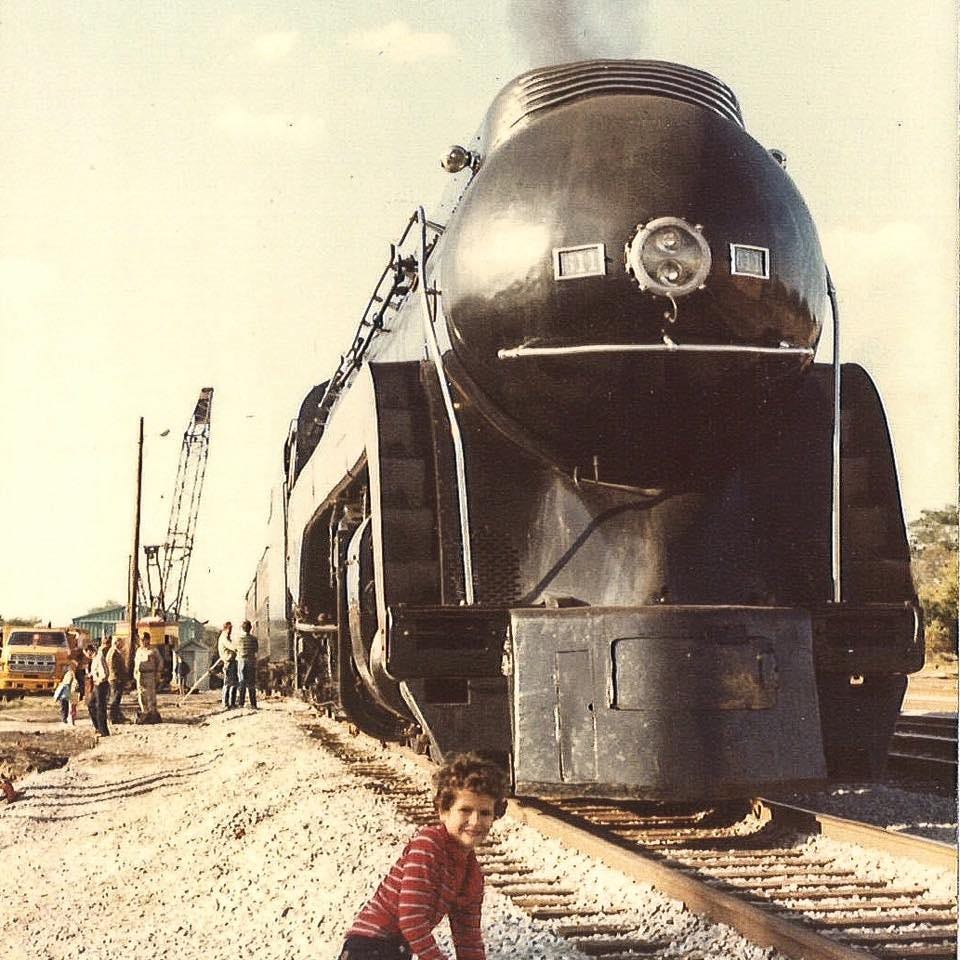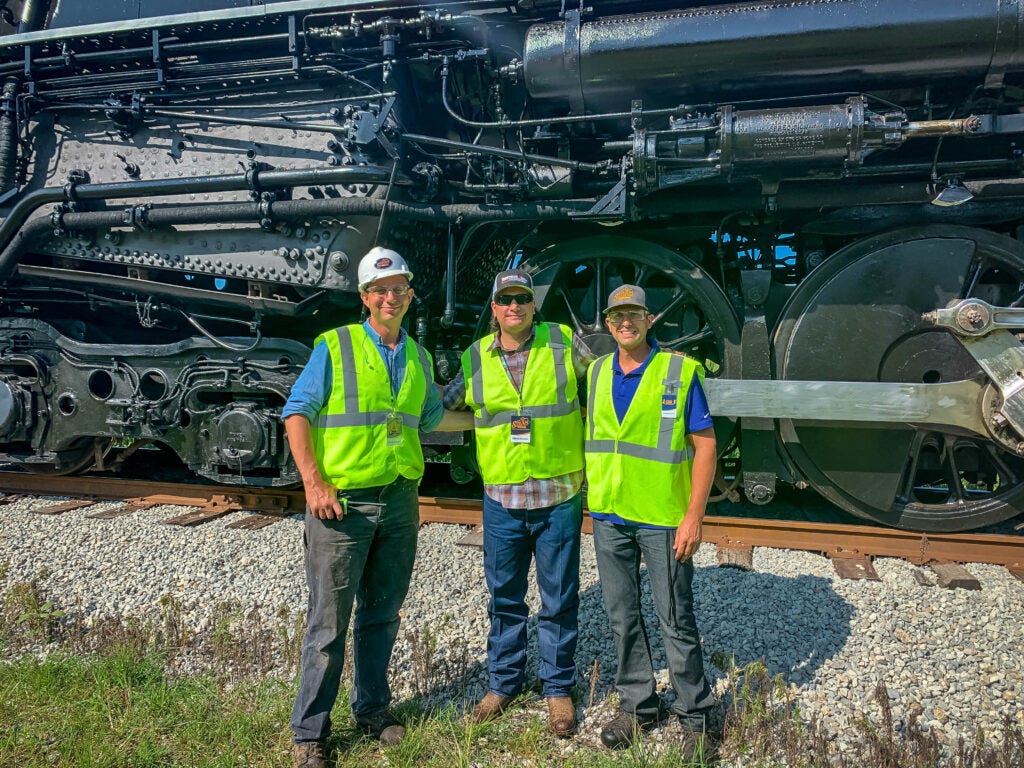Chris Campbell – Thinking Outside the Firebox
Behind the Throttle - Edition 1, Installment 15
“We have to be mindful of the past but aware of the future”
Chris breaks to bottle on the Chesapeake and Ohio 2716, to christen the beginning of his organization’s restoration.
With so many figureheads within the world of railroad preservation, it’s easy to get lost in the everlasting ideas and principles that dictate how to run a rail society. While respecting the way of doing things from the past is the stronghold of our initiative as preservationists, it’s also important to understand new ideas and think critically about ways to better perform the fundamental tasks within a historical rail group. Today, we speak with someone who, rather than being an armchair railroader on the internet, started on his own path with new ideas. Behind the Throttle is proud to feature Chirs Campbell, founder of Kentucky Steam, and someone who isn’t afraid to think outside of the firebox.
Chris’ story began similarly to most, with him developing an interest in trains as a young boy. Living in Lexington, Kentucky in the early 1980s provided him with a frontrow seat to the famous steam locomotive program hosted by the Southern Railway -later Norfolk Southern. He recalled hearing the distant whistles, then immediately going down to the tracks by his house, where he could often see the Norfolk and Western 611, the Norfolk and Western 1218 or even the Southern 4501 on an excursion. Steam excursions were so common, that even recalled an instance where he walked out of the supermarket one day, and casually saw 611 cruise through town, to which no one gave a second thought (As a young railfan born after the heights of modern steam excursions, this really blew my mind)! However, Chris followed the usual timeline and his interest in trains faded as he grew up and moved onto something new – in his case, baseball. He mentioned that on one of 611’s final trips when he was 16, he chased the trip solo just after receiving his driver’s license, as a sort of swan song to his interest in trains.
Young Chris is seen here with the Norfolk and Western 611, a crucial part of his childhood passion for steam trains.
Following his time in high school, Chris moved onto college and graduated with a degree in business administration, and got a job working with a construction management firm. Following this,he was financially successful for a number of years, which gave him freedom to explore some of his other interests upon leaving that job. Chris then spent a few years working as a musician, and would play gigs for his main source of income. He then decided to go full circle and landed back at his university where he volunteered coaching their baseball team until he was offered a full time position there. Through all of this, trains remained in the back of his mind. In 2004 Chris visited a friend out in Los Angeles, and by chance had an opportunity to see the Santa Fe 3751 steam locomotive on an excursion run. With a lack of something better to do, Chris took to the road and followed the steam train on its run over Metrolink tracks, and felt a wave of nostalgia as his childhood love flooded back. However, his job provided him with very little time off, so Chris seldom had time to dedicate to this rekindled passion. He made a trek out to Owosso, Michigan in 2009 for the annual Trainfest celebration, where several steam locomotives made appearances, but this opportunity was one of the only chances Chris had to explore the hobby he wanted to get back into.
Chris managed to find his way into the cab of the ATSF 3751 steam locomotive during his brief visit to California in 2004.
In 2015, a staple of Chris’s childhood was brought back to life following a lengthy restoration. With the 611 fired up, Chris’s passion was ignited with it. He set out to see the Norfolk and Western locomotive for the sake of nostalgia, but was quickly drawn to a new element of steam railroading that he never saw before. As a complete outsider to the world of trains and all of the politics that surrounded mainline trips in that era, Chris looked at the economics and logistics of these trips from an angle that he felt was valuable. After seeing 611 take to the high iron once more, Chris was fired up too. He was ready to get involved. Eager to be the driving force with his own path, he opted to start a new organization where he could try what he thought would work. Rather than focusing solely on trains, Chris wanted to focus on everything around trains: the work that goes into restoration, the effect they had on the history of their homes, and most importantly the community that surrounds the railroad. With this mission in mind, Chris set out to found the Kentucky Steam Heritage Corporation.
Kentucky Steam Heritage Corporation (KSHC) is Chris’s brainchild that he spent years developing. His goal was to create a new type of preservation society, where trains were embedded into a cultural center that featured other attractions. Once the groundwork was laid, Chris and his team began working to find a home for their idea, and eventually settled on the former CSX Freight Car Shop in Ravenna, Kentucky. It took several years to convince CSX to sell his group the land, but after many emails, lots of diplomacy, and even more patience, in 2018, CSX agreed to sell them the land. KSHC’s main goal at that point was refocused to restore the Chesapeake and Ohio 2716, a 2-8-4 steam locomotive, and use the engine to help revitalize the community and bring some economic development back to the region in the form of tourism. The local communities near the Ravenna-based operation all back this initiative, with many of them having connections to the railroads that brought the region up in the first place. By using the power of trains, Chris hopes to help transform a region in need of new development into a modern tourist destination and a multisensory preservation experience. Chris identified to me how several organizations fail to have a catch factor that attracts an audience beyond train enthusiasts. He hopes to circumvent this with his project by having a music venue, restaurants, a campsite, and more present at the KSHC campus, which will hopefully attract a wide variety of visitors, and potentially influence some to develop an interest in trains.
Chris riding along in the cab of the Nickel Plate Road 765 in 2018.
Moving forward in the world of historical preservation, Chris hopes to form an adaptable and sustainable method of displaying what the past of railroading looked like. “We have to be mindful of the past but aware of the future,” he explained to me, outlining his group’s hopes of running a steam engine for the foreseeable future. One thing he stressed to me was how preservation groups should be mindful of the current times and adapt so that they can continue to spread the word of history while still being cognizant of modern circumstances: “Be prepared to be adaptable, operate under the parameters of 2021, 2031, and even 2041”. As Chris’s organization continues to gain support and followers, it’s important to note that preservation is a changing game and by following a mission of simply running a train, you limit yourself in the possibilities of your organization. To keep the past alive, think outside the normal parameters and be prepared to make changes. While preservation represents where we’ve been, we must continue to move forward with how to showcase the past.
Chris (right) with Jason Sobczynski and Jeff Lisowski, in front of the C&O 2716, while it was being moved to the KSHC facility in Ravanna, KY.
Thank you for reading this edition of Behind the Throttle! If you enjoyed this narrative, please join our mailing list to get updates on futures. As always, I am Max Harris, and I’ll see you all down the line.







